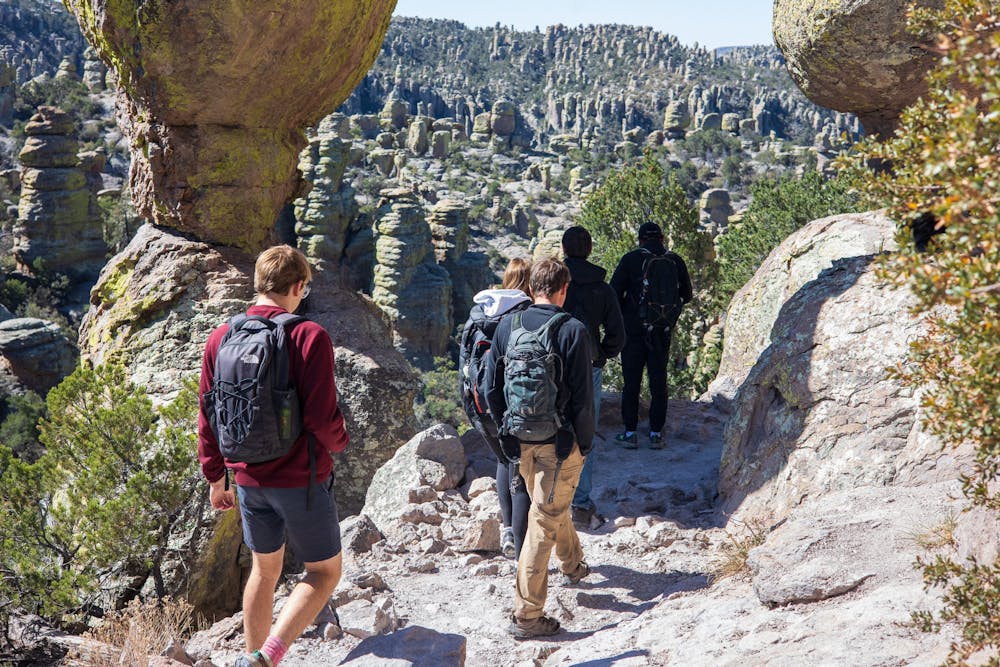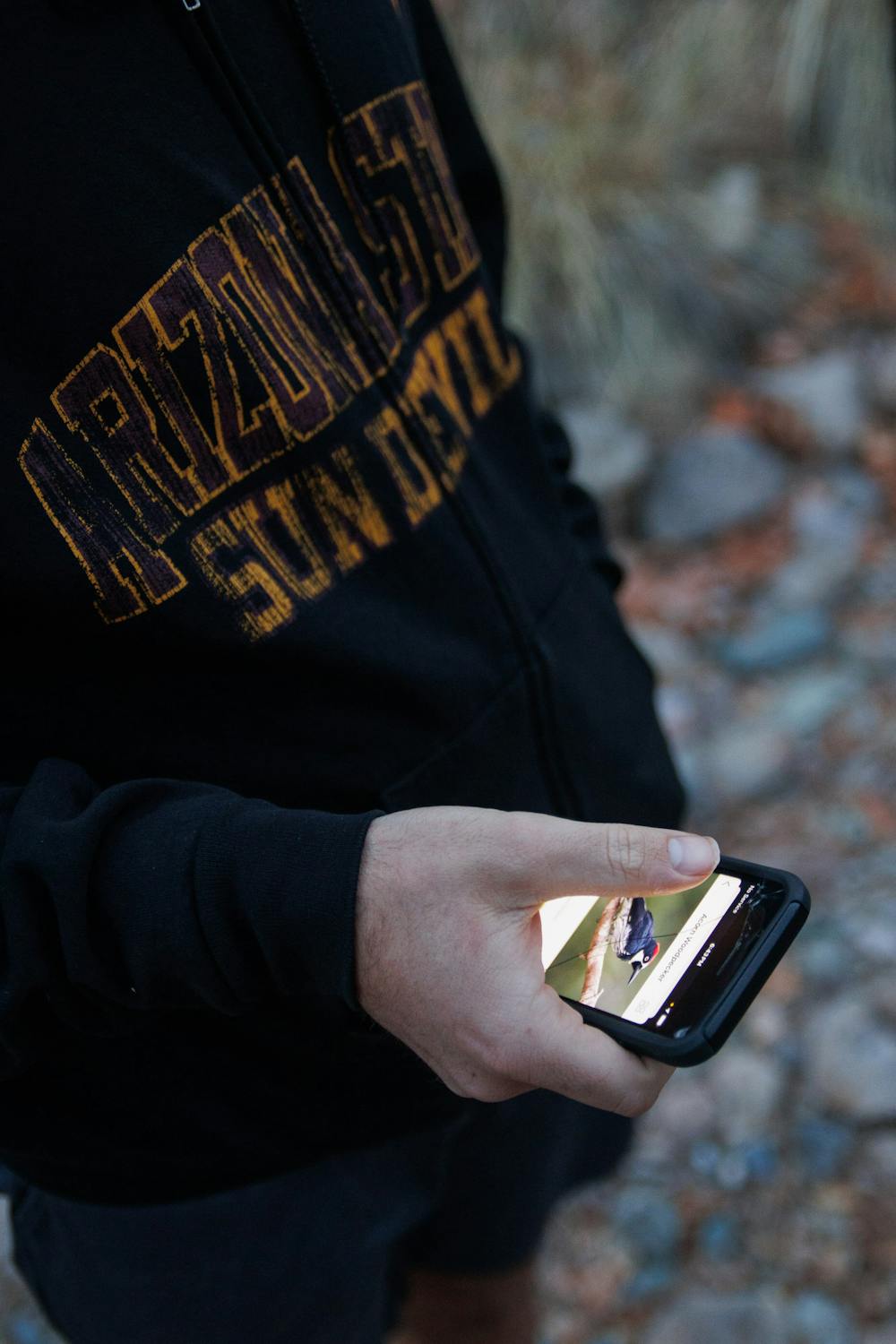Every Arizona Outdoors Club trip starts in the same place: the parking lot of Trader Joe's on the intersection of University Drive and Rural Road. The trip leader chats with attendees as they roll in, while stragglers pick up any items they may have forgotten before embarking on an overnight journey.
Each trip is organized by a trip leader, an experienced member who ensures the group's safety. Trip leaders are expected to bring any extra gear needed, plan routes and make sure the whole group arrives at each location.
"On any trip, you're guaranteed to be with a trip leader who's camped a lot before and several other people who have a lot of experiences," said Samuel Ingram, a trip leader and a junior studying applied math. "People, especially for new campers, are always super friendly, like willing to help."
Eventually, after getting to know the group for this particular excursion, gear is distributed throughout multiple cars and Google Maps coordinates are sent to the drivers. The group rolls out of the parking lot together but quickly splits, unable to stay together on the chaotic Arizona highways.
The number of people on each trip can range from less than 10 to more than 70, depending on the level of skill required for the adventure.
According to Ingram, hikes at the Arizona Outdoors Club fall into three main categories: easy, moderate and hard. Easy hikes are mostly flat with little to no elevation gain, moderate hikes feature elevation gain but no big steps or scrambling, and anything with high elevation, scrambling or large steps between rocks is considered hard.
LISTEN: ASU outdoors club president talks about extreme heat hiking
In hiking terms, scrambling is when the hiker has to use their hands to pull themself up or through a rock. It is not quite rock climbing, but more difficult than stepping normally. The hike for this weekend, an eight-mile loop with a few add-ons to bring it up to 10 miles and a total of almost 2,000 feet of elevation gain, falls into the moderate category.
"We've had a lot more high-intensity trips than I remember in my first year," Ingram said. "My first year, it was a lot more chill camping trips, and we still have that, but I think this year's been a lot more larger trails and extreme hikes."
The person behind the transition to more extreme hikes was already at the campsite when the main group arrived after three and a half hours of travel time. Justin Weidmann, a senior studying electrical engineering and a trip leader, had successfully led a hike earlier in the day and was preparing to join the main group for the next day's trek.
"I lead at least two trips a month, usually more," Weidmann said. "I usually focus on the hardcore stuff, mountain hiking and stuff."
Trips normally last two days with one day taken up by getting to the location and camping overnight before hiking the next morning. But, the club also provides one-day adventures for people newer to the club and three-day expeditions for more experienced members.
"We do backpacking, camping, day trips, hiking," Weidmann said. "We've done rafting in the past, canoeing. I did a canyoneering trip that was fun."
READ MORE: National parks layoffs affect AZ parks, worry experts and adventurous students
Once at camp, members assemble their tents and go hunting for wood and dry grass to build a fire. At altitude, temperatures can drop below freezing at night, making a campfire essential. Throughout the night, gear is unpacked and dinners are made.
Everyone is expected to bring their own food and water, but camping gear can be reserved and borrowed from the club. Members have free access to sleeping pads, sleeping bags, tents and backpacks on a first come first serve basis.
Jaddison Jordan, a freshman studying computer information systems, found the club on Sun Devil Sync.
"It's a really good way to get into it because backpacking gear, camping gear, it's really expensive," Jordan said. "So being able to get that rented out for free and go with experienced people so you know you're not going to f--- up and die... it's a good way to get into it and see if you like it."
At the beginning of each semester, the club hosts a kickoff trip where it teaches students camping basics. Those who enjoy the experience can branch out into more specific outdoor activities such as backpacking or caving.
"That first trip, no one had gone backpacking before and that trip was really fun because it started hailing really hard," Jordan said. "Some people didn't have rain jackets and all these new backpackers, they just kept going. I can't believe no one wanted to turn around."
The rest of the night is spent exploring the campsite or trading stories around the fire. While away from cell service, campers spend the trip disconnected from the hustle and bustle of campus life. Soumitra Savasheri, a graduate student studying engineering, grew up hiking and found a way to continue through the Arizona Outdoors Club.
"I joined the group in August and since then I've been hiking every weekend," Savasheri said.
No alarms are set, but the camp is broken down by 8:30 a.m. so the team can hit the trail early. A few minutes later, cars are on the dirt road out of the wilderness in the direction of Chiricahua National Monument. Canyon walls rise alongside the two-lane road as the train of vehicles enters the park.
The group takes a pit stop at the Visitor Center, picking up maps to be used both as keepsakes and a backup plan in case of emergency. A short drive later and the parking lot of Echo Canyon Loop trailhead hoves into view.
"Being able to see things, not just being stuck in a room every weekend, it's really nice," said Will Green, an exchange student studying math. "I feel like that's what most ASU exchange students end up doing unless you know someone with a car."
The first portion of the hike is a winding descent into the canyon, trees close overhead and the chatter of birds breaks up the silence when the group is not talking.
"Being able to meet so many different people. I think that's been really good," Green said. "They get a really good mix in the club."
A few miles later, the group reaches the first of the planned viewpoints for the day and is rewarded with a stunning view of the snow-capped Chiricahua Peak.
The club has existed in some form or another since 1964 and has a few trips it repeats every year. The majority, however, are pitched by trip leaders or club members.
The Chiricahua trip was pitched by Ingram, who insisted on including Inspiration Point in the route. The detour added a mile to the total length and an hour to the total trip time, as the group paused to enjoy the full view of the canyon and desert beyond for more than 30 minutes.
"The more spectacular the place, the more memorable," Ingram said. "The reason I came back here is, this was one of my most memorable trips just because I'd never heard of this place before, and I'm like, 'Oh my goodness, it's so cool.'"
Over 7,000 feet above sea level, group members take their time to scribble their names on a notebook stashed in a geocache. A geocache is a box placed in a specific location by a random person where visitors can leave random objects, notes or signatures for the next person to find. They are scattered in natural places around the world, with longitude and latitude coordinates listed in a public database.
The Arizona Outdoors Club stumbled upon this one by accident but left their mark. A few miles later the group returned to the cars, said their goodbyes and began the long descent back to reality.
Edited by Senna James, Sophia Braccio and Natalia Jarrett.
Reach the reporter at allipper@asu.edu and follow @lippert_audrey on X.
Like The State Press on Facebook and follow @statepress on X.
Audrey is a sophomore studying journalism and mass communication with a minor in Spanish. This is her first semester with The State Press. She has also worked at Blaze Radio.





